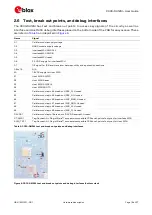
C030-R412M - User Guide
UBX-19010121 - R01
Hardware description
Page 20 of 27
Figure 7: C030-R412M Arduino™ UNO R3 connectors
2.8
Power supply options and LiPo battery usage
The C030-R412M can be powered up from several resources, individually or all together. The power
supply usage configurations are provided in
# Connector
Description
1 Debug USB
Uses development PC’s USB 5 VDC VBUS to power up the utility and application sections of
the C030-R412M. It charges up the LiPo battery if it is connected.
2 Aux 5V USB
Auxiliary USB power input. A USB power supply could be connected to power up only the
application section of the C030-R412M.
It charges up the LiPo battery if it is connected. There is no communication functionality.
3 Serial USB sniffer
Uses Development PC’s USB 5 VDC VBUS to power up only the application section of the
C030. It charges up the LiPo battery if it is connected. The serial USB sniffer circuitry could
only be powered from its dedicated USB connector.
4 LiPo battery
The C030 application section could run only from a LiPo Battery connected. If one or many
of the #1, #2, #3 USB connections are available. The LiPo Battery is charged up as well.
5 Arduino™ UNO R3 VIN Pin 8
Arduino™ UNO R3 VIN pin 8 could be used to power up entire the C030 application section
except serial USB sniffer circuitry. STLink (or CMSIS-DAP when available) feature could be
used through the debug USB. However, the C030-R412M application section including LiPo
Battery management circuitry is disconnected.
The VIN input voltage should be in the range of 2.5 VDC to 5.5 VDC.
Table 7: C030 power supply options and LiPo battery usage
☞
The C030-R412M could run on a single supply input from #1 debug USB or #3 serial USB sniffer.
However, the cellular module transmission power demand might not be satisfied from these
connections. In such a use case, the C030-R412M might suffer brownout due to USB VBUS supply
rail cuts because of USB current limitations. Therefore, either a 5 VDC USB power supply with
~3 ADC capacity should be connected to the Aux 5V USB connector and/or an adequate LiPo
battery, such as a BAK LP-503759-IS-3, should be connected to the LiPo battery connector. The
locations of the power supply connections are shown in
It is recommended to use a LiPo battery in addition to the USB connections, because high
frequency current demands might not be provided by the USB VBUS rails.








































